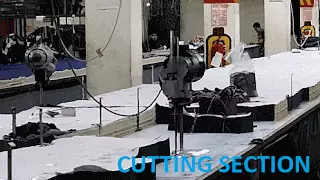Fabric Cutting Room
Fabric Cutting, the first manufacturing step of Garments manufacturing, here cut fabrics as per marker in order to sew garments product. Cutting should be fully accurate as per marker, otherwise cutting deviation will affect garment fitting. There are many works involved in the cutting section, keeping the same shade, numbering, bundling, and cutting as per the same pattern. The cutting section plays an important role in any garment manufacturing industry. This article is about the Flow Chart of Garments Fabric Cutting Room in the Garments Industry.

Flow Chart of Cutting Room in Garments Industry
- Here we discussed the flow chart process by process:
Bulk Cut Procedure: To be reminded to follow the bulk cut procedure as approved in the pre-production stage. - QC/QI Instruction: To instruct Quality supervisors, Quality Controllers and Quality Inspector about the job there assign to do in detail
- Style Cut Plan: To have a systematic cut plan for Cutting, Concerning CI, Garment Delivery Plan, and Production Plan.
- Day Cut Plan: To have a day cut plan for the preparation of cutting requirements for the coming day
- Day Issuing Plan: The day issuing plan will be a guideline to issuing recorder for the Quantity to be issued as per the day’s planned requirement.
- Fabric Receiving Record: To have records for fabric received by the Cutting Department in detail.
- Cut Instruction: To have order quantity cut as per Buyer’s P.O. quantity.
- Fabric Relaxation: To have control over fabric shrinkage in order to produce garments to be within the buyer’s spec. Relaxation has to be done before the fabric spreading process.
- Marker Checking: To ensure the marker which is going to be cut is correct as per the pattern; ratio and other requirements are met in order
- Spreading Report: To have control of each Layer, Quantity, and End Bit Details, and to make records of fabric utilization as per marker.
- Spreading Checking: To ensure the Spreading is maintained and controlled in order to assure all cut components are as per the buyer’s acceptance and Quality standards.
- Cut Inspection: To ensure the cut which is going to be issued to sewing will be acceptable in order to proceed with the production.
- Bundle Guide Chart: To distribute cut quantity in bundles to guide and maintain bundle sequence, quantity, and part numbering sequence.
- Daily Cutting Report/WIP: Daily Report being kept available for the Management Information.
- Fusing Inspection: To assure that fusing is acceptable on the panel to not reject the garment.
- Printing & Embroidery Inspection: To ensure that Printing & Embroidery is acceptable in order to proceed with sewing to minimize and control garment rejection.
- Cut Panel Replacement (Print & EMB): To Re-cut panels for replacing Printing and Embroidery defects.
- Delivery to sewing department: The step in the cutting room is, to send all cut panels to the sewing section.
Flow Chart of Garments Fabric Cutting Room
